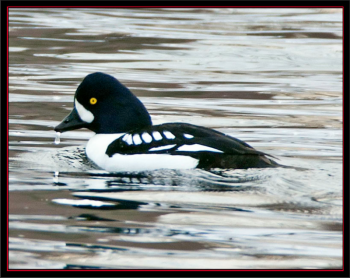Wonderful Winter Waterfowl
Scanning through flocks of ducks bobbing in the cold ocean waters on a frigid winter day may not be a kind of birding that suits everyone. But here in Maine we are blessed with some wonderful winter waterfowl treasures to enjoy. Some of them are pretty hard to find south in other parts of the eastern U.S. The king eider, for example, is one that occasionally shows up among the large flocks of our familiar common eider. The male’s bright orange bill and powder blue head will start any birder’s heart racing with excitement. Maine is also fortunate in that we have more harlequin ducks than anywhere else on the East Coast. Some say that the exquisite slate blues and brick reds of the male harlequin duck make it the most beautiful of all waterfowl.
But one of our favorites has always been the Barrow’s goldeneye. Like its more widespread and abundant sibling species the common goldeneye, the Barrow’s goldeneye male is a study in black and white. That’s not altogether true as, under close viewing conditions and good light, the seemingly black head of males of both species show some color—a greenish sheen in the common goldeneye and a purple one in the Barrow’s. Both species have an area of white in front of the eye. In the common, the white is more or less a round spot while in the Barrow’s the white is a striking crescent moon. There are some other differences—puffy head in Barrow’s rather than a rounded head in common, white spots along the lower edge of the black back in Barrow’s, a more yellow bill in female Barrow’s.
Here in Maine, it’s possible to find a few Barrow’s goldeneye wherever common goldeneye flocks occur—Barrow’s have been seen at Ocean Point in some years—but there are particular locations that host concentrations of the species every winter. In the Penobscot River, the Bucksport area typically has hosted a flock of wintering Barrow’s as has Belfast Harbor and the Kennebec River in Waterville-Winslow near old Fort Halifax.
Barrow’s goldeneye have an unusual distribution, with a small population that breeds in Quebec and Labrador and winters mostly in the St. Lawrence but with small numbers that make it down to us in Maine. Another population also occurs in Iceland. But the largest population is a totally separate one in western North America that nests and winters from Alaska south to California. While the eastern population of Barrow’s goldeneye is thought to number between 4,000 and 4,500 individuals, the western population is thought to be between 200,000 and 250,000 birds.
Both goldeneye species nest in tree cavities so are very reliant on mature forests near water in which woodpeckers like pileated woodpeckers and northern flickers have excavated cavities. There is still a fair amount of uncertainty as to the full extent of the breeding range of the eastern population of Barrow’s goldeneye as many of the boreal forest areas in Quebec and Labrador where they may occur are remote and little visited by birders and ornithologists.
If you haven’t seen a Barrow’s goldeneye, now is a great type for a little birding adventure!






























